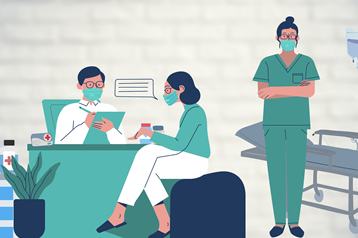Newsletter Article
Use a Microadaptive Learning Strategy to Enhance Group Coaching Effectiveness
Fri Apr 16 2021

When it comes to group coaching, we usually default to instructor-led lectures or e-courses. However, we know that the effectiveness of those types of coaching will never match one-on-one coaching. Paired with adaptivity and game mechanism, microlearning can potentially transform traditional check-to-complete passive learning into agile and active personalized experiences. Like any good learning design, microadaptive learning needs a guiding framework and takes careful thinking.
This article will explore the best practices of microadaptive learning design, key components of microadaptive learning design, motivational game mechanism, and microadaptive framework to personalize any group training experiences—all based on decades of research and my consulting practice in learning design.

Benjamin Bloom discovered in the search for methods of group instruction as effective as one-to-one tutoring that 98 percent of participants who learned through one-on-one tutoring performed substantially above the average versus those who learned through group-based learning or lecturing.
So, is there a way to make group coaching as effective as one-on-one coaching? To answer this question, we need to first explore the concept of microadaptive learning. Microadaptive learning is an integration of microlearning and adaptive learning. Microadaptive learning leverages available technologies and techniques to facilitate real-time one-on-one tutoring for groups, at scale. It delivers microcontent bites incrementally and systematically at various intervals, such as days, weeks, or months and has a lasting impact on learning transfer and behavioral change. Those microcontents are usually one piece in a much bigger and comprehensive knowledge inventory.

Image by Elf-Moondance from Pixabay
Best Practice of Micro-Adaptive Learning Design
If we were to coach a group of healthcare workers on the emotional support and alleviation of fear and anxiety for patients through a microadaptive approach, we would need two stages: analysis and prescription.
Analyze Our Learners
During the analysis stage, we learn about our learners in terms of motivation, learning preference, prior knowledge, and potential challenges. We can ask our learners a few questions:

Motivation & Goals: How seriously is the learner committed to the goal? Are there competing goals?
Preferences: Even though learning styles don’t exist, how does the learner prefer to receive information? What kind of resources are generally easier to digest? Is there a preferred sequence or frequency?
Levels of Knowledge: What mastery level is the learner? Does the learner possess all the prior knowledge required? What other critical background knowledge or experiences may support the learner later?
Potential Challenges: What are some common learning challenges for this learner? How likely can this person be distracted? What common misconceptions, fear, or mistrust may exist? How disciplined is this learner in terms of self-regulation and time management? How clearly can this learner reflect on learning? More potential mental challenges can be found here.
We may record those analyses and refer back when we design and delegate training.
Scaffold Mastery Levels
Think of scaffolded microlearning objectives as a tree. Begin with the final task in mind and ask, “What subtasks are needed to perform this task?” Then ask, “What sub-subtasks are needed to perform this subtask?” Keep breaking the tasks down into the most basic ones. Before we know it, we will have a hierarchy of microtasks and microlearning objectives (MLOs).
We can also integrate game mechanism levels of mastery to indicate various tiers of complexity. Learners need to pass one level to reach the next. For example,

Microlearning objective MLO: Anxiety support for patients in the waiting room.
Mastery Level 1: Can successfully identify signs of emotional stress in patients.
Mastery Level 2: Can provide support to alleviate emotional stress in patients.
Mastery Level 3: Can support fellow healthcare workers identify and calm stressful patients.
In terms of corresponding content, we can design reading, videos, problem-based scenarios, serious learning games, and more. Let’s try to keep those resources short and sweet so people don’t get overwhelmed.
Leverage Social Game Mechanism
Do you remember a time when a colleague easily explained or showed something that you took forever to figure out? That’s the power of peer-to-peer engagement. According to “Mechanism of User Participation in Co-creation Community: A Network Evolutionary Game Method,” there are a few ways to encourage peer-to-peer engagement in a microlearning environment.

Fair rewards. Maximize rewards of active learning behaviors and minimize returns of passive learning behaviors. For example, folks who actively participate in discussion forums or coaching fellows, get extra points or financial rewards. Rewards also tend to wear off, so try to design different incentive systems to encourage different learning behaviors.
Smart groups. Divide participants into small groups and encourage passive participants to maximize group rewards rather than punish them. For example, add points or rewards for a group when each member contributes to a common task or competition.
Thought leaders. Invite thought leaders to share high-quality insights on various hot topics to ignite conversations. When the community gets chatty, even the lurkers will be tempted to participate.
Encourage reciprocation. When people feel a positive feeling after reciprocation, they are more motivated to continue the collaboration. To promote reciprocation, the game system needs to be fair, focus on a good reputation, and encourage punishment for those who seek to take advantage of others, such as free riders.
Provide choices. When people have the option to make choices, they are motivated to act. For example, in addition to taking a quiz to get points, offer learners other options to receive points such as mentoring others.
Introduce cost. When we reward our learners for active learning behaviors, we can also ask users to pay for high-quality time, relationship maintenance, and high-quality knowledge. For instance, a learner can offer to pay to obtain coaching from a peer.
Design Microquizzes and FeedbackMicroquizzes can have multiple-choice questions and open-ended questions. For each question, design and provide immediate well-phrased feedback in the context of complete sentences. Feedback usually comes in five types of adaptations:
1. Remedial adaptations are most commonly used to point learners in the right direction or go for an easier question when a learner provides an incorrect response.
2. Capitalization adaptations are used when the learner provides the correct response on a basic level and needs a bit of digging to understand the topic more deeply.
3. Preferential adaptations are used when the learner needs a special advantage. For example, the learner will be given more simplified content to overcome comprehension insufficiency.
4. Compensatory adaptations are used to overcome learning weaknesses, such as difficulty with hearing, seeing, or listening. You can provide a transcript or enlarge the text for easier access.
5. Challenging adaptations are used when the more challenging content will support learning objectives. For example, if the goal is to implement anxiety-comforting practice, then the learner needs to practice learned strategies in real work situations. You can also read more instructional strategies here.
Let’s bring all this into a role-based simulation scenario.

Getting StartedHere are a few guiding questions to think about when designing a microadaptive learning experience:
· Who are our learners? What are their motivations, goals, preferences, and levels of knowledge? What are some potential challenges for them?
· What are our microlearning objectives? Are they scaffolded like LEGO pieces? Is the content well designed with clear language and supportive visuals?
· What social game mechanisms and reward systems will you design? How would you encourage active learning while minimizing passive learning?
· How do you plan to design quizzes and feedback into a role-based scenario? Are quizzes and feedback aligned to the microlearning objective?
When we have a scaffolded map of microlearning objectives with corresponding content, mastery levels, smart social game mechanisms, well-designed scenario quiz questions, and feedback, we will have a good framework to make our learning microadaptive as well as maximize group learning retention and experiences.
Read more if you are interested:
“The Cognitive Challenges of Effective Teaching”
“MLaaS: A Cloud-Based System for Delivering Adaptive Micro Learning in Mobile MOOC Learning”
“Microlearning: A Pathway to Effective Training Retention and Behavioral Change”
“Social Decision-Making: Insights From Game Theory and Neuroscience”
You've Reached ATD Member-only Content
Become an ATD member to continue
Already a member?Sign In
